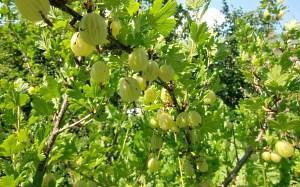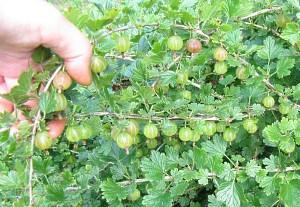How to transplant gooseberries correctly - gardener's advice
 Sometimes you have to do redevelopment at the summer cottage or in the garden. For this you have to cut down trees and replant shrubs. Then the question arises - when can you transplant gooseberries? The answer is simple - the gooseberry is transplanted in the fall or spring.
Sometimes you have to do redevelopment at the summer cottage or in the garden. For this you have to cut down trees and replant shrubs. Then the question arises - when can you transplant gooseberries? The answer is simple - the gooseberry is transplanted in the fall or spring.
How to choose the right place for a gooseberry transplant?
Autumn or spring is the best time of the year to organize a gooseberry transplant. And yet, when is it better to transplant gooseberries?
The most optimal season for the gooseberry transplant process is autumn, or rather October or September.

When selecting a site for the necessary transplant of gooseberries in the fall, some important points should be taken into account:
- Gooseberries love places where there is good sunlight;
- Where the wind blows, it is impossible to transplant gooseberries;
- The soil should not be wet and without proximity to groundwater, since the gooseberry does not like constantly highly moist soil;
- The earth should be loamy, if it is not suitable, then this is easy to fix, for example, if there is a lot of clay, or the soil is heavy, then it is advisable to add a little sand, and otherwise you can add clay;
- It is unacceptable that the soil has high acidity; in this case, lime must be added to reduce acidity;
- It is not recommended to transplant gooseberries to areas where currant or raspberry bushes were previously grown because of common pests, in which case they will very quickly harm the shrub.
After the selection of the area for the gooseberry transplant process has been made, you should dig up the ground and remove the remnants of various rhizomes and all weeds. Further near the bush, all unnecessary and old branches should be cut off, thereby leaving no more than seven of the youngest and healthiest shoots, which should be shortened before transplanting, leaving two-thirds of the entire length of the shoot.
Subsequently, annual pruning of the shrub is necessary, since only branches and stems that grew last year bring berries. Only six or eight new shoots should be left each year. In this case, the shrub will bring a large harvest of gooseberries.
Possible gooseberry transplant methods
 The process itself does not take so much time. Everything is done sequentially and in stages:
The process itself does not take so much time. Everything is done sequentially and in stages:
- The prepared gooseberry bush is dug around, the distance directly from the bush should be at least 30 centimeters.
- If there are thick roots, then they can be safely chopped off, either with a shovel or with an ax.
- Subsequently, by means of a scrap or a shovel, the bush must be removed from the soil and be sure to put it on a plastic wrap so that it can be transported to a new site for transplantation.
- In the selected area for transplanting the gooseberry, a pit is pulled out, it needs to be made a little larger in diameter than the gooseberry root system.
- The depth of the hole should be approximately 50 centimeters.
- The hole is abundantly supplied with water, for this you need to pour about 70 liters of water into the hole, this is about 3-4 buckets.
- Then part of the removed soil should be mixed with compost, and in no case with fertilizers, otherwise the root system will be damaged and the end result will be disastrous.
- After the gooseberry bush is installed in the hole, the remaining gaps should be filled with earth.
- The soil should be tamped down and watered again with a good amount of water.
- At the end of the gooseberry transplant, the bush is sprinkled with dry soil, and mulch is sprinkled on top, you can use peat chips.
- Before the onset of frost, the shrub should be systematically watered.
- It is not necessary to cover the bush for the winter.
There is another way to transplant gooseberries, but it is suitable for mass transplanting, that is, in large summer cottages:
- The main difference is to immediately prepare a place for transplanting the gooseberry, where to outline the holes for transplanting.
- The bushes are transplanted in an ordinary way, including the inter-row space (the distance between the rows should be at least 1.3 and not more than 1.5).
- If several bushes are transplanted with gooseberries at once, then you need to know that the distance between the bushes should be at least 1.5 and not more than two meters.
- Further, the bushes are dug out using standard technology.
- You need to transplant the gooseberry one separate bush into the prepared pits.
- If the diameter of the hole is less than the rhizome of the bush, then it must be increased.
- The rest of the procedure is done in exactly the same way as with a separate bush.
 If necessary, you can watch how the gooseberry transplant is carried out in the fall, the video provides an opportunity to visually make sure that a lot of effort and time is not required.
If necessary, you can watch how the gooseberry transplant is carried out in the fall, the video provides an opportunity to visually make sure that a lot of effort and time is not required.
In the fall, a gooseberry transplant is carried out, not only because in the spring you can be late to transplant it due to the fact that the shrub has already begun to prepare for fruiting, but also in order to clear part of the site under garden bed, flower bed or lawn.
Also, the methods of transplanting gooseberries can be useful to gardeners for propagating this berry bush. Transplanting a gooseberry in autumn guarantees a high survival rate of the shrub, so a good harvest of berries will already appear next year.
A little about leaving after gooseberry transplant
Gooseberry bushes are not whimsical. Care is limited to removing weeds, which is advisable to carry out by hand, since roots that are close to the surface of the earth can be damaged by tools intended for weeding.
Of course, gooseberries require watering and feeding. In order to satisfy the need of the gooseberry bush for obtaining nutrients, it is only necessary to create a new protective layer once a year in the fall, which consists of soil mixed with compost and organic fertilizers... If desired, the mulching layer can be increased, it will contribute to good fruiting and faster growth of the shrub.